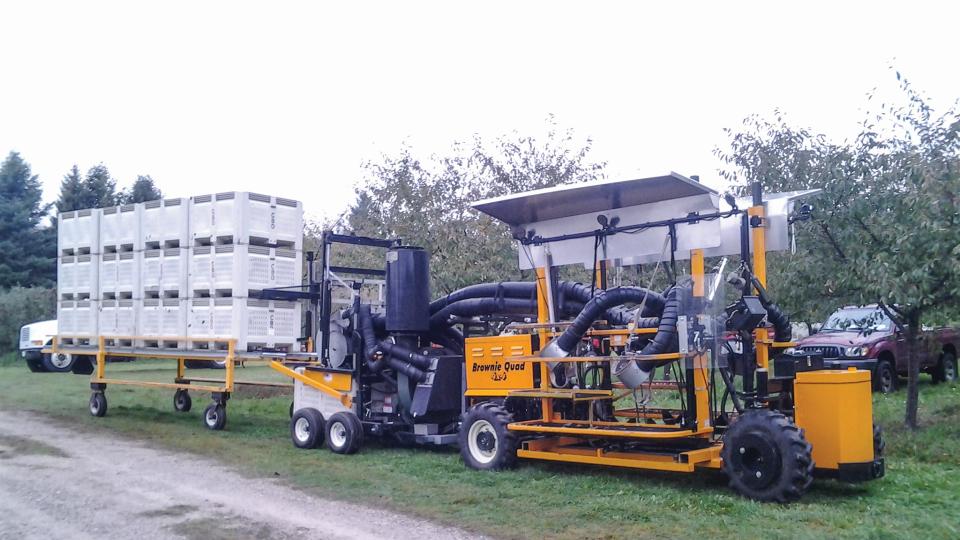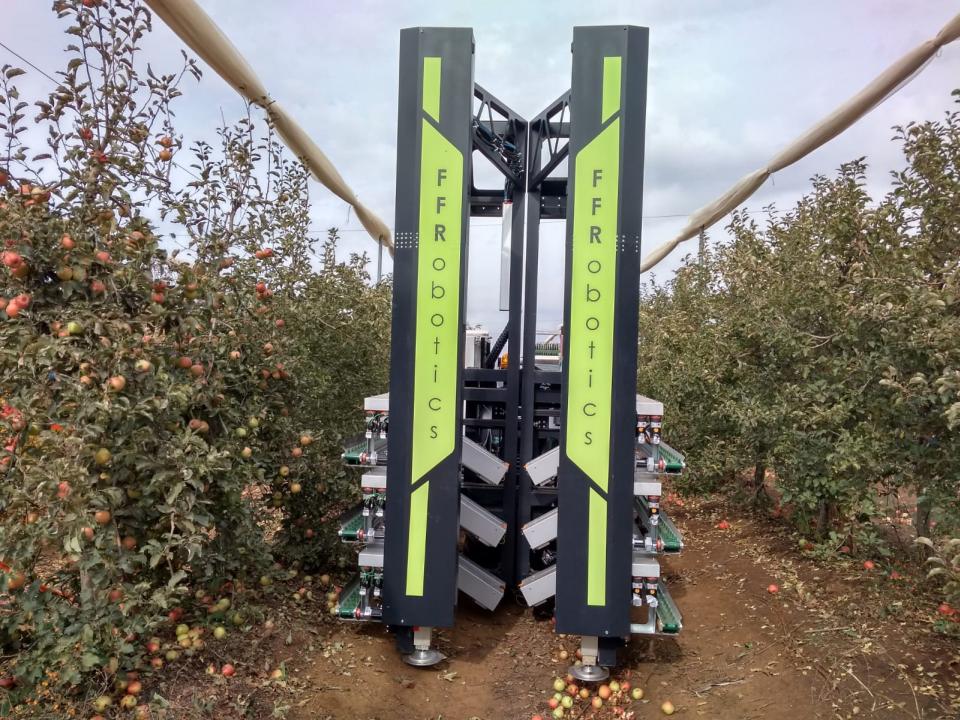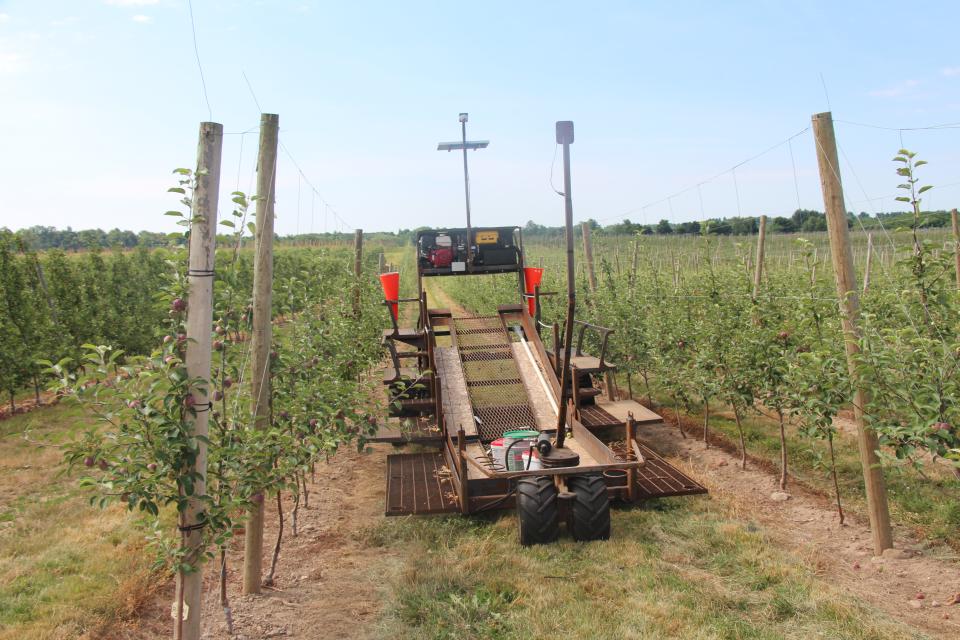The Road to Orchard Robotics Has Not Been Easy

“It’s great to build a thing that works great, but if it’s too expensive to be saleable, it’s not going to do anybody any good,” Phil Brown, Owner of Phil Brown Welding of Conklin, MI, says. Photographed here is the Apple Harvester on a Brownie Quad Self-Propelled Work Platform. (Photo: Phil Brown Welding)
It’s no secret that the growing season is one steady race to harvest. There’s months and months of preparation, planning, pruning, thinning, and weather. But, essentially your entire year boils down to about 50 or so days of apple harvest. It’s also one of the costliest parts of fruit growing. You have to get fruit off when it’s ready — and that in itself is its own exact science.
So, it seems only natural that orchard equipment would focus on improving efficiencies and reducing orchard harvest costs.
Ladder harvest is an inefficient act, no matter how fast your best pickers are. Think about the seconds accumulating as a picker has to climb down the ladder, walk over to the bin, dump the apples into the bin, walk back to the tree, move the ladder to the next tree, climb up the ladder and start the process again.
With modern fruiting walls, it’s true the time may be reduced, but with more narrow canopies, less fruit will hang on a single tree — so the distance to fill a bin will only increase.
A couple of months ago, Abundant Robotics announced the first commercial apple harvest using their automated harvester. This feat could signal a change in how apples are harvested. And, growers have probably wondered to themselves ‘what took you so long?’
But the process of taking idea to concept to prototype to commercial machine isn’t always as simple as putting pen to paper.
In fact, it’s been a long time coming.

“There’s never a shortage of harebrained ideas. That’s how you keep moving forward. I’ll paint it pink. We’ll put a rocket engine in the middle and put some wings on it and fly to the moon. If somebody wants to finance it, I’ll build it,” says JJ Dagorret, owner of Automated Ag in Moses Lake, WA. Dagorret is working with Phil Brown to include Brown’s DBR suction system on an Automated Ag Bandit XPress platform. (Photo: Automated Ag)
The Design Process
It can take several years to go from initial concept to commercial product. But that’s because there’s a lot to consider when it comes to design.
“I kind of approach everything from their view. ‘What if it was me growing this fruit? These are the problems and issues that I would have,’” JJ Dagorret, owner of Automated Ag in Moses Lake, WA, says.
It’s critical, he adds, to keep in mind the delicate balance of cost vs. functionality. Because, in the end, that’s going to impact a grower’s willingness to make a purchase.
Phil Brown, Owner of Phil Brown Welding in Conklin, MI, agrees.
“It’s great to build a thing that works great, but if it’s too expensive to be saleable, it’s not going to do anybody any good,” he says.
Every part and piece that goes into these machines costs money, and it’s a balancing act between what makes sense from a commercial standpoint and what makes sense from a functional standpoint.
“It’s eight weeks of considering every tiny little detail, and then you look at the parts,” Dagorret says. “What parts can we reach out and touch? What’s price-reasonable? What’s the quality that we need on certain parts to put on the machine, high-wear things. What kind of tire do we need? There’s just as ton of little things that go into it.”
But that can be the most enjoyable part of equipment design: working with growers to bring concepts to life, even if they’re a bit out there.
“There’s never a shortage of hare-brained ideas. That’s how you keep moving forward,” Dagorret says. “I’ll paint it pink. We’ll put a rocket engine in the middle and put some wings on it and fly to the moon. If somebody wants to finance it, I’ll build it.”
But, there’s also a responsibility to create something that will function in all types of terrain and for all sorts of users.
“We try to build stuff extra heavy because farmers are going to misuse it,” Brown says.
And, there’s always opportunity for revision through field trials, says Walter Wafler, Manager of Huron Fruit Systems in Wolcott, NY.
“You take your best shot in terms of design — and you go out and you try it and you figure out what you messed up,” Wafler says. “If you can iterate that cycle, you can refine the product quickly.”
“As an entrepreneur, I can only confirm what everyone knows: It always takes more time and more money than you think it will take,” Kahani says of robotics development. “It is an evolution; there are no miracles.”

The FF Robotics harvester has 12 arms on each side that will pick apples simultaneously. (Photo: FF Robotics)
The Challenges to Design
“We’ve seen a lot of changes, naturally, over the years from the big ‘ol standard trees, to dwarf trees, right on down to the slender spindle and really small trellised orchards,” Brown says.
While trees have gotten smaller, that doesn’t mean the planting styles are consistent. In fact, they’re not.
“It’s a kind of a roller coaster. Sometimes you think you solved the problem, and when you move to the next orchard you find out it’s not the same and there’s no standards,” Avi Kahani, Founder of the Israeli company FFRobotics, says.
Dagorret agrees, noting, “They seem like they’ll plant a tree anywhere. It doesn’t matter. They’ll plant on top of a mountain. Some of the terrain, you just wonder.”
Brown says growers need to be able to use the equipment in a variety of orchard systems and to work with a variety of bin sizes, whether or not you think they’re standard.
“A guy says, ‘I’ve got a standard bin,’ and I say, ‘there’s no such thing as a standard bin,’” Brown says.
And then there’s overhead cooling, or drip irrigation, or any additional structures for netting and the like.
Dagorret says he realized pretty quickly that running a platform for ‘Gala’ harvest with overhead cooling in Washington was going to be a challenge, or “a mud hole,” as he called it.
Wafler says another challenge is getting a grower to demo a piece of equipment during harvest. Growers are often hesitant to shake up their day-to-day harvest functions in the thick of things. Or even worse, have a workforce that refuses to use the equipment.
“We actually had one customer who bought a machine, and his labor force said if you want us to use that, we’re not going to work for you,“ he says, noting that this grower relied on non-H-2A workers, who had the ability to make such demands.

“Here we’re saying, throw your ladders away, retrain your crew, and move your bins differently. If you’re a grower, that’s not something you want to take lightly, especially if you have a system that works,” says Walter Wafler, Manager of Huron Fruit Systems in Wolcott, NY. This is one of Huron Fruit System’s platforms unpainted that Paul Wafler tinkers with. Walter Wafler says his brother, Paul, has refined the platform from constant use in their family’s orchard. (Photo: Christina Herrick)
What They Want You to know
Kahani says he first thought about automating harvest in the 1980s.
“Everybody talked about how a robot was going to replace us in the next three to five years — that was in the ’80s.”
So, it’s taken a while.
“As an entrepreneur, I can only confirm what everyone knows: It always takes more time and more money than you think it will take,” Kahani says of robotics development. “It is an evolution; there are no miracles.”
But there are definitely things you can do to help move the needle forward. Dagorret says implementing mechanization and harvest assist isn’t as easy as just plopping a few machines in an orchard. If you don’t have management buy-in and training, it’s going to fail.
“These guys buy the machine and put it out there and want it to just work,” he says. “It requires management, it requires a thought, a program, and a plan. We always try to talk them into hiring one person that will be the platform guy. Somebody that’s got a positive attitude, because you get a lot of pushback in the beginning.”
Dagorret also says attitude is everything. If your team sees the machine as a nuisance, that is going to trickle down to your workforce, and you’re going to have a hard time implementing anything. He says a big pet peeve of his is when growers say, “‘I’ve got one guy that picks eight bins.’”
He’s quick to point out that of the 50 people out picking in that orchard, the rest average five bins. And, that speedy picker isn’t going to be picking forever and is eventually going to slow down, not to mention getting into the potential quality issues that fast picker might have.
Wafler agrees, noting this transition can be daunting.
“Here we’re saying, throw your ladders away, retrain your crew, and move your bins differently,” he says. “If you’re a grower, that’s not something you want to take lightly, especially if you have a system that works.”
With the investment you’ve put into these machines, it’s critical you approach their use the right way.
“For every guy that can’t make their program work, there’s a guy that can,” Dagorret says. “The most rewarding thing is to go out with something, get some guys on it, and 10 or 15 minutes later, bins start coming out of the back of it and everybody’s happy.”










